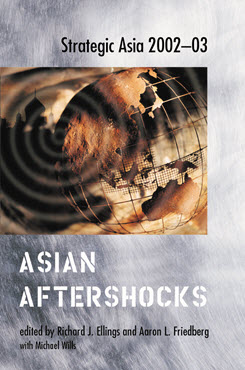Central Asia (Strategic Asia 2002-03)
This chapter outlines the five Central Asian states’ development in their first decade of independence, examining how each regime approached issues of political and economic reform, and assessing the rise of radical Islamist groups across the region. It then looks at geopolitics of Central Asia before September 11, 2001. The subsequent section examines the extent to which the Central Asia strategic environment has changed post-September 11, marked especially by the major increase in U.S. influence in the region. A concluding section looks ahead and suggests how this changed strategic landscape might affect political and economic development within the states, and explores some of the risks and opportunities of greater U.S. engagement in the region.
The September 11 terrorist attacks on the United States and subsequent U.S. military action in Afghanistan brought Central Asia into the news, reminding the international community of the strategic importance of the region and the consequences of ignoring the region’s problems. Ousting the Taliban eliminated a major security risk for the Central Asian states, and the renewed western interest in the region created an opportunity for these states to “get it right” by redressing the mistakes of the first decade of independence.
For all of President George W. Bush’s initial reluctance for the United States to engage in “nation-building,” this is precisely what his administration is now doing, in Central Asia as well as in Afghanistan. The United States is taking an active role in facilitating economic and political institution building as well as cooperation in security relations. U.S. troops are now stationed in the region, at the Khanabad base in Karshi, Uzbekistan, and at Kyrgyzstan’s Manas airfield (now renamed Peter Ganci in honor of New York City fire fighter who was killed in the attack on the World Trade Center). U.S. forces have also made use of facilities in Tajikistan and have been given limited landing rights in Kazakhstan as well. In addition, Turkmenistan has been a major transit point for humanitarian assistance bound for Afghanistan.
The ouster of the Taliban was a very positive development from the point of view of the Central Asian states, as the leaders of most of these countries saw the ideological nature of the former Afghan regime as threatening to their secular visions of nationhood. The region’s leaders were also bothered by the high level of toleration that the Taliban clerics showed for drug traders and international terrorist groups such as the Al Qaeda network. The degree of perceived threat varied over time and from state to state, but, from late 1999, all of the region’s leaders except Turkmenistan’s Saparmurad Niyazov strongly supported the goal of regime change in Afghanistan.
A deepening sense of fear set in throughout the region after a series of terrorist bombings in Tashkent in February 1999 and later that summer when an armed incursion by the Afghan-based Islamic Movement of Uzbekistan (IMU) captured villages in Kyrgyzstan and took several foreigners hostage.
This chapter outlines the five Central Asian states’ development in their first decade of independence, examining how each regime approached issues of political and economic reform, and assessing the rise of radical Islamist groups across the region. It then looks at geopolitics of Central Asia before September 11, 2001, both in terms of inter-state relations and the roles and influence of major external powers such as Russia, China, Turkey, Iran, and the United States. The subsequent section examines the extent to which the Central Asia strategic environment has changed post-September 11, marked especially by the major increase in U.S. influence in the region. A concluding section looks ahead and suggests how this changed strategic landscape might affect political and economic development within the states, and explores some of the risks and opportunities of greater U.S. engagement in the region.
Strategic Asia
The Strategic Asia annual edited volume incorporates assessments of economic, political, and military trends and focuses on the strategies that drive policy in the region. Learn more about Strategic Asia.


